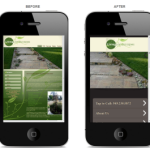Are you a small business owner with a website? Okay, grab a smartphone and go to your website. Tell me, what does it look like? Is it all scrunched and small? Even worse, does it have code that that makes the website inoperable?
Or even worse yet, is it flash based and your website doesn’t work at all? It is absolutely ridiculous to lose a potential customer that is looking for your services on their mobile device because your website doesn’t work on mobile devices.
According to Google, two thirds of mobile users will go to a different website if they can’t quickly find what they are looking for. With smartphones and tablets becoming more common each and every day, it’s important that your site is viewable on these devices.
Here are three different ways you can go:
1. Full Blown Mobile Site
This is a site that is designed specifically for a mobile device. Here’s how it works. Some code is placed within the website that detects what type of device the browser is using. If they are using a  desktop or laptop, they are given the full version of the site. If they are using a mobile device, then a mobile version of the website is displayed. It’s pretty cool. A nice way to go.
desktop or laptop, they are given the full version of the site. If they are using a mobile device, then a mobile version of the website is displayed. It’s pretty cool. A nice way to go.
Now this goes even further. There software that can be installed for many websites that will automatically turn your website into a mobile version, HOWEVER it is much more basic than designing a full blown mobile website, but it is free. If you want a nice, custom mobile website, you need to have one designed for you.
It’ll have such features as tap to call, tap for directions, gallery, etc. I don’t think everyone needs a mobile site, but for certain industries they can come in handy. Custom mobile websites are ideal for restaurants, locksmiths, cab companies etc. Basically if you have somebody that searches from a phone at a high percentage of the time, then a mobile website is the way to go.
2. Standard Website
If you have a fairly recent website that isn’t flash based, and doesn’t have a lot of java, then it’ll probably show up just fine on a mobile device.
Just keep in mind that some things will require much more time to do, clicking on links, you’ll have the pinch and zoom, etc. So, if you are fine with that, then go for it. That is what I prefer when I am browsing typically, but it just depends on the website that I am visiting.

3. Responsive Website
This is a website that ‘responds’ to the screen size and adjust accordingly. A responsive site basically takes your website and adjusts everything so it can show up on your screen. Flash doesn’t work small typically you have a really long webpage on your phone and you’ll scroll down and down, there isn’t scrolling to the side so much. Not my favorite method, but it is becoming increasingly popular.
Google recommends webmasters follow the industry best practice of using responsive web design, namely serving the same HTML for all devices and using only CSS media queries to decide the rendering on each device.
If responsive design is not the best option to serve your users, Google supports serving your content using different HTML. The different HTML can be on the same URL (a setup called dynamic serving) or on different URLs, and Googlebot can handle both setups appropriately if you follow our setup recommendations.
So what do you need to do? Think of your visitors. Think of your target demographic. What type of website would be best for them? What gives them the best user experience? Then, test, test, test. You can install Google Analytics on your website and then see how many people come from mobile phones, how long they stay on there, etc. So test, and see what works best.
If you have a flash base website, or want a mobile website, let’s talk. Chances are I can help improve your customer experience, with the ultimate goal of making you more money.
Titan Web Agency specializes in helping healthcare professionals such as dentists, and others doctors, get online and build up their presence, to become authority’s in their field, and market.